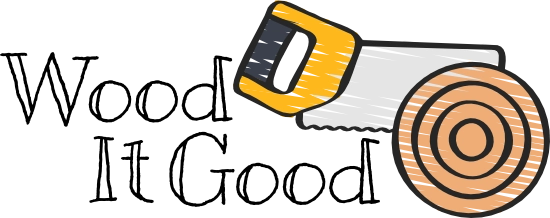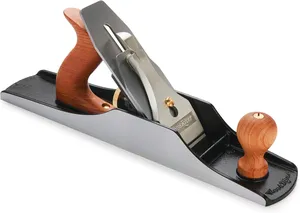WoodItGood is supported by its readers. We may earn an affiliate commission at no extra cost to you if you buy through a link on this page.
Are you lookin’ to add a solid all-around workhorse to your tool collection?
Then it’s high time you thought about getting yourself a Jack Plane. This bad boy is the go-to hand plane for all sorts of woodworking tasks.
It’s big enough to handle tough jobs like flattenin’ and squarin’ boards, but nimble enough to fine-tune your work too.
But before you go snappin’ up the first one you see, let’s talk about what you should be lookin’ for when buying your first Jack Plane.
Trust me, makin’ the right choice now will save you from a heap of headaches later!
Our Favorites
Size: Finding the Sweet Spot
Now, when it comes to a Jack Plane, size matters!
Most Jack Planes are around 14 to 15 inches long, which is right in that sweet spot between a smoothing plane and a jointer plane.
The longer length helps you get boards nice and flat, but it’s still short enough to handle a variety of tasks.
If you’re just starting out, a No. 5 Jack Plane is what you’re gonna want to grab.
It’s the most common size, and you’ll find it’s perfect for a whole range of woodworking jobs, from leveling out rough lumber to preparing boards for final smoothing.
Blade Quality: Sharp and Durable
As with any plane, the blade (sometimes called the iron) is the heart of the tool.
You’ll want a high-quality steel blade that can handle heavy cuts but still sharpen up easy when it starts to dull.
A Jack Plane is used for heavier work than a smoothing plane, so the blade will need to be tough.
A2 and O1 steel blades are both great options. A2 holds an edge longer, which is nice if you don’t want to be sharpening all the time.
O1 is easier to sharpen but might wear down quicker. Either way, a good sharp blade is key to getting the most out of your Jack Plane.
Cambered or Straight Blade?
Here’s where things get a little technical, but stick with me.
You’ve got two main blade shapes to choose from: cambered (curved) or straight.
A cambered blade has a slight curve to it, which is perfect for taking big, rough cuts when you’re trying to quickly level a board.
The curve prevents those annoying track marks from forming in the wood.
On the other hand, a straight blade is better for more precise work, like jointing edges. If you’re mostly using the Jack Plane for rough work, go with the cambered blade.
But if you want more versatility, a straight blade might be your best bet.
Sole of the Plane: Flat as Can Be
Just like with a smoothing plane, the sole (or bottom) of the Jack Plane needs to be flat as a board.
This helps ensure that your plane moves evenly across the wood, without leaving any bumps or ridges.
Some planes might need a little tuning to get that sole perfectly flat, but don’t let that scare you off. Once it’s tuned up, you’ll be able to plane boards so flat, you could balance a penny on ‘em!
Weight: Heavy Enough to Do the Job, Light Enough to Handle
When it comes to weight, a Jack Plane should feel solid in your hands but not so heavy it’s wearin’ you out.
You want it to have enough heft to glide smoothly over the wood and handle tough grain without you havin’ to push down too hard.
Recommended Reading: Hand Plane Types: A Beginner’s Guide for Woodworkers
A heavier Jack Plane will help you power through rough lumber, but if it’s too heavy, you’ll end up with sore arms faster than you can say “pass the sandpaper.”
Find a plane with a good balance, one that’s heavy enough to help, but light enough that you’re still in control.
Adjustable Frog: Fine-Tune Your Cuts
The frog is the part of the plane that holds the blade and allows you to adjust its position.
A Jack Plane with an adjustable frog is a big plus. It lets you fine-tune how much of the blade is exposed, which can be a real help when you’re workin’ with different types of wood.
Movin’ the frog forward gives you a finer cut, while pullin’ it back allows for deeper, rougher cuts.
This kind of versatility is one of the reasons Jack Planes are so handy. You can go from rough stock removal to almost smoothing-level work just by adjusting that frog.
Comfort and Grip: Get a Good Hold On It
Last but not least, you’ll want to make sure the Jack Plane feels comfortable in your hand.
Check out the handles (or totes)… are they smooth, sturdy, and easy to grip? You’re gonna be using this tool for long stretches, so it’s gotta feel right.
Whether the body is made from cast iron or wood, make sure the handles fit nicely in your hands and that the plane feels well-balanced when you’re pushin’ it along.
If it feels awkward or clunky, it’s probably not the one for you.
So, when you’re pickin’ out your first Jack Plane, keep these things in mind: size, blade quality, cambered vs. straight blade, a flat sole, the right weight, an adjustable frog, and a comfortable grip.
Get yourself a good Jack Plane, and you’ll be able to tackle just about any job that comes your way.
That’s about all I’ve got on Jack Planes for today! If you’ve got any more questions, just holler, and I’ll get back to you quicker than a squirrel findin’ an acorn in October. Happy planin’, y’all!





